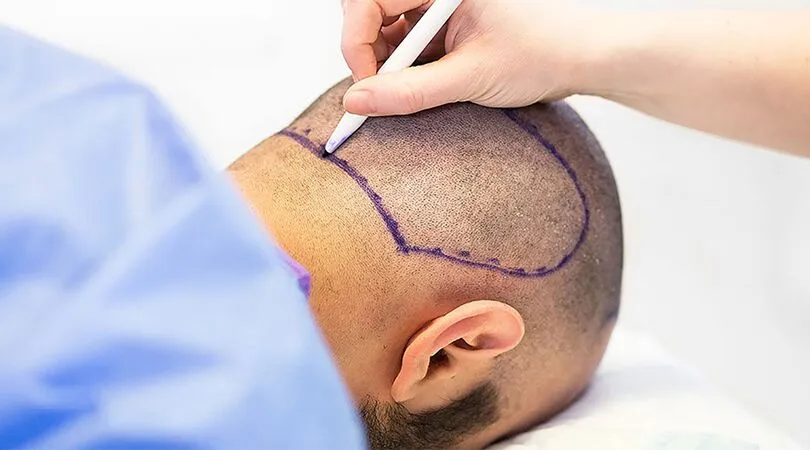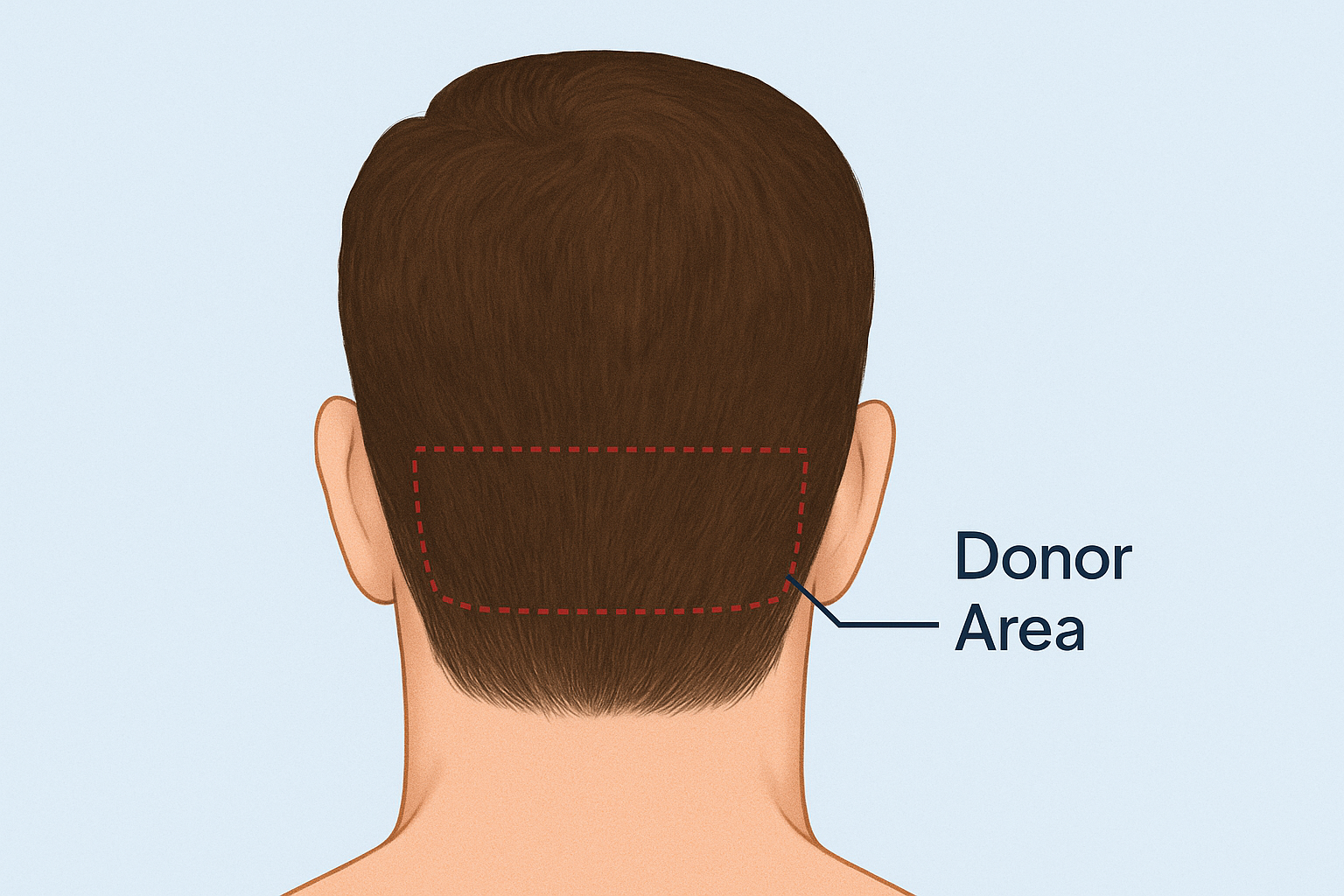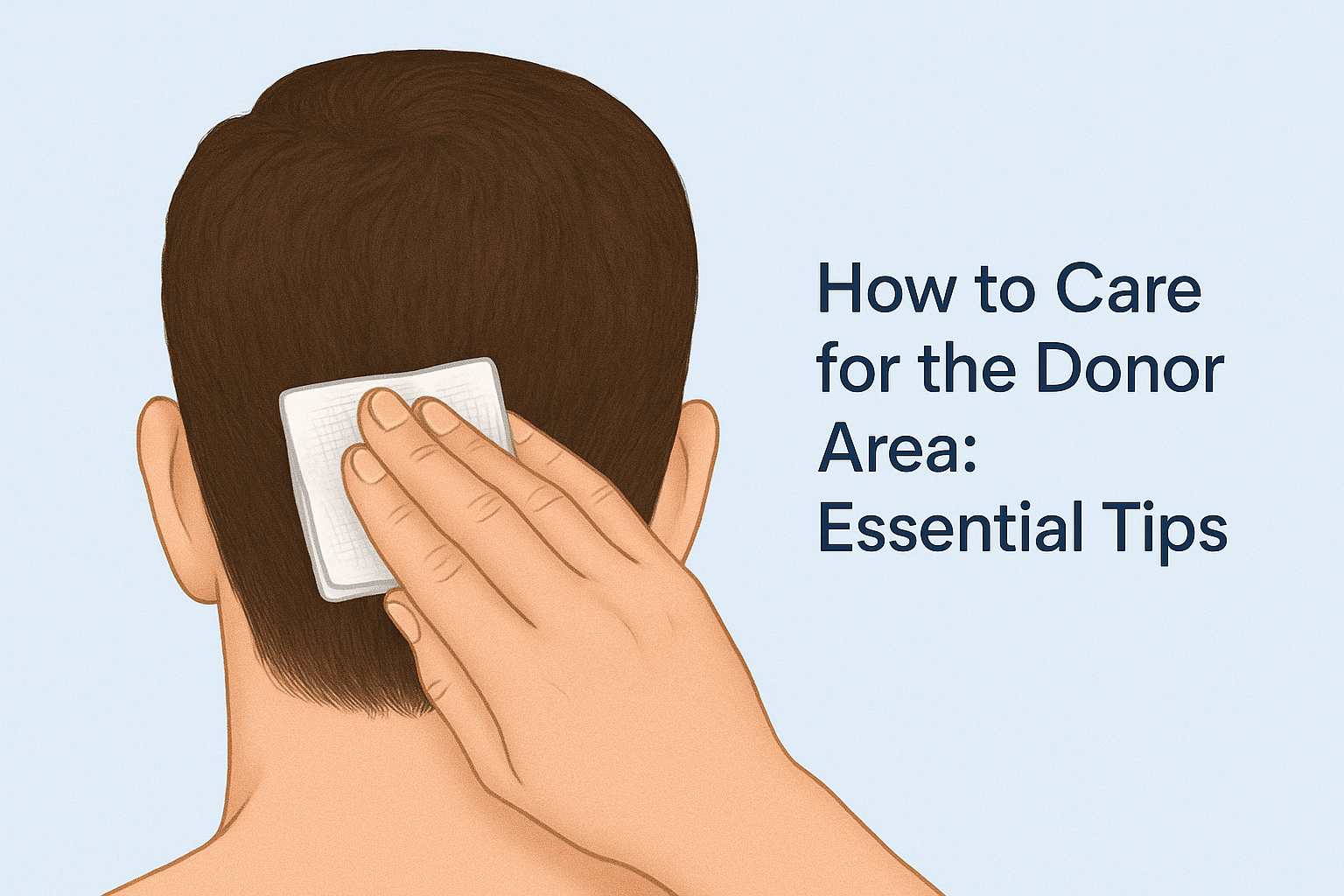Donor Area Recovery After Hair Transplant: Hair transplant procedures have become increasingly popular for those seeking a permanent solution to hair loss. While most discussions focus on the recipient area where the new hair grows donor area recovery is equally important for a successful and natural-looking result. At Hair Legends, a leading hair transplant clinic in Antalya, we prioritize not just the aesthetic outcome, but also your healing journey.

In this guide, we explain what happens to the donor area after a hair transplant, how to care for it, and what to expect during the recovery process. Whether you’ve chosen FUE (Follicular Unit Extraction) or DHI (Direct Hair Implantation), understanding donor site healing is key to a smooth and satisfying experience.
What Is the Donor Area in Hair Transplant?
The donor area refers to the region of the scalp where healthy hair follicles are harvested. For most patients, this is the back and sides of the scalp—areas that are genetically resistant to balding. These grafts are then transplanted to balding or thinning areas (recipient site).

Because the donor area is typically dense and permanent, it is essential to keep it healthy and undamaged throughout the procedure and recovery process.
What Happens to the Donor Area After the Surgery?
After a hair transplant, especially with FUE or DHI techniques, the donor area may show:
- Small red dots or scabs
- Mild swelling or tenderness
- Slight numbness or itching
- Occasional tightness or crust formation
These are normal healing responses. The extent of trauma depends on the number of grafts extracted and the technique used. FUE leaves micro scars that fade over time, while DHI, being a variation of FUE, shows a similar recovery pattern.
Day-by-Day Donor Area Healing Timeline
Day 1–3: Immediate Post-Op
- You may feel tightness, soreness, and sensitivity in the donor zone.
- Small crusts or scabs will begin to form around the extraction points.
- Avoid touching or scratching the area.
Day 4–7: Crusting and Itching
- Scabbing becomes more visible.
- Itching may increase—this is a sign of healing.
- You can gently start post-op washing with the recommended medical shampoo.
Week 2: Visible Improvement
- Crusts begin to flake off.
- Redness and inflammation reduce.
- Itching and discomfort subside.
Week 3–4: Subtle Scarring
- Any residual scabs disappear.
- Micro-scars begin fading.
- Normal skin texture gradually returns.
Month 2–3: Full Healing
- Donor site appears almost fully recovered.
- Hair starts growing back in the donor zone, camouflaging any signs of extraction.
- You may begin light grooming and haircuts with care.
How to Care for the Donor Area: Essential Tips

To ensure proper healing and avoid complications, follow these guidelines carefully:
Avoid Physical Pressure
- Do not sleep directly on your back if possible during the first few days.
- Use a neck pillow to prevent contact and friction.
Use the Recommended Medical Shampoo
- Hair Legends provides a special post-transplant shampoo formulated to soothe and cleanse the donor zone gently.
Apply Healing Spray or Lotion
- Some clinics recommend PRP spray or growth factor serums to speed up healing.
Avoid Sun Exposure
- UV rays can worsen scarring.
- Wear a loose-fitting hat if you go outside, especially in sunny climates like Antalya.
No Smoking or Alcohol
- These substances impair circulation and delay wound healing.
Don’t Scratch or Pick Scabs
- Let them fall off naturally.
- Picking can lead to infections or visible scarring.
FUE vs DHI Donor Area Recovery: What’s the Difference?
Both FUE and DHI use similar donor extraction methods. However:
| Aspect | FUE | DHI |
|---|---|---|
| Extraction Size | 0.7–1 mm punches | 0.7–1 mm punches |
| Scarring | Minimal dot scars | Minimal dot scars |
| Recovery Speed | 10–14 days | 10–14 days |
| Donor Density Impact | Mild to moderate | Mild to moderate |
Recovery is largely the same in both methods, but Hair Legends uses Sapphire-tipped tools for more precision and faster healing in both techniques.
What Can Go Wrong If You Don’t Care for the Donor Area Properly?
Neglecting the donor site can result in:
- Infection
- Prolonged redness or swelling
- Visible scarring
- Delayed healing
- Permanent thinning of donor zone
That’s why aftercare is not optional—it’s crucial.
Donor Area Scar Visibility: Will It Be Noticeable?
In FUE or DHI, scars are usually tiny dots that are invisible even with short hairstyles (like a #1 guard). However, if too many grafts are taken from a small area or improper tools are used, overharvesting can occur—leading to visible thinning or patchy appearance.
At Hair Legends in Antalya, our surgeons ensure a balanced graft extraction across the donor area to avoid overharvesting and ensure a natural look post-recovery.
How Long Until the Donor Area Looks Normal Again?
- Most patients return to work within 5–7 days, especially if they wear longer hair.
- In 2–3 weeks, most scabs are gone.
- Within 1–2 months, full healing is generally achieved.
- Hair regrows in the donor area, camouflaging any extraction points.
How Many Times Can the Donor Area Be Used?
Your donor area is finite. On average:
- 5,000–7,000 grafts can be safely harvested in a lifetime.
- It depends on donor density, scalp elasticity, and prior surgeries.
Proper planning ensures future sessions (if needed) remain viable. At Hair Legends, we evaluate your long-term needs, not just the immediate session.
PRP & Stem Cell Support for Donor Recovery
At Hair Legends Antalya, we offer PRP (Platelet-Rich Plasma) and Exosome Therapy to accelerate tissue healing in the donor zone. These treatments:
- Boost blood flow
- Minimize scarring
- Reduce redness
- Encourage faster hair regrowth
We include PRP in many of our transplant packages as part of our premium aftercare.
Why Choose Hair Legends Antalya for Hair Transplant?
Located in the heart of Antalya, Hair Legends is recognized for:
- High graft survival rates
- Expert DHI and Sapphire FUE surgeons
- International patient services
- Transparent pricing with no hidden fees
- Dedicated post-op support team
From your donor area to the final results, your comfort and long-term satisfaction are our mission.
Frequently Asked Questions (FAQ)
Will the donor area hurt after the transplant?
Mild discomfort or tightness is common for the first few days but is well-managed with prescribed pain relievers.
Can I use hair products on the donor area?
Not in the first 2 weeks. Use only clinic-recommended shampoos and sprays.
Can I exercise after the procedure?
Avoid heavy physical activity for at least 10 days to prevent sweating and pressure on the donor area.
What if I need a second transplant later?
With proper donor management and healing, a second session is very possible. Always consult with an experienced surgeon to avoid donor depletion.
Get a Free Consultation Today
Curious about your own donor area suitability or recovery potential? Contact us today at Hair Legends Antalya for a free online consultation. Our specialists will assess your scalp, recommend the best technique, and create a personalized recovery plan—ensuring not just amazing results, but a comfortable and confident journey too.
🌍 Website: www.antalyahairlegends.com
📍 Location: Antalya, Turkey
✈️ Packages Available With Hotel, Transfers & PRP
